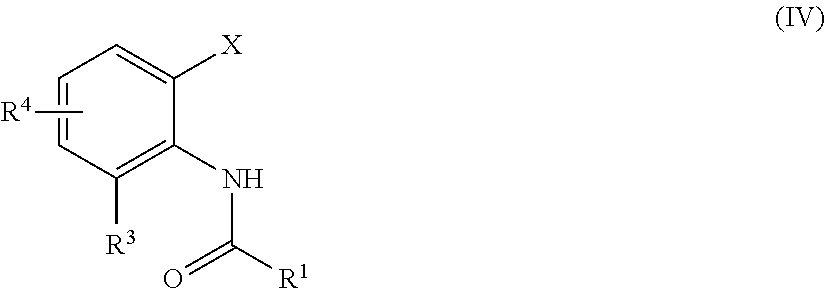Method for producing substituted anthranilic acid derivatives
- Summary
- Abstract
- Description
- Claims
- Application Information
AI Technical Summary
Benefits of technology
Problems solved by technology
Method used
Image
Examples
preparation examples
[0091]The Preparation Examples which follow illustrate the invention without limiting it.
example 1
2-Acetamido-5-cyano-3-methylbenzoic acid
[0092]
[0093]In a 30 ml autoclave, under nitrogen as protective gas, 2.54 g [10 mmol] of N-(2-bromo-4-cyan-6-methylphenyl)acetamide, 3.89 g [21 mmol] of tri-n-butylamine, 0.131 g [0.5 mmol] of triphenylphosphine, 0.035 g [0.05 mmol] of bis(triphenylphosphine)palladium(II) chloride and 2 g of water are combined. After closure, the autoclave is purged with carbon monoxide and heated to 110° C., and a carbon monoxide pressure of 10 bar is maintained After 18 hours, the mixture is allowed to cool to room temperature, the autoclave is depressurized, the reaction mixture is stirred with methylene chloride and filtered through kieselguhr, and the filtrate is washed, first with dilute hydrochloric acid and then with water, dried over sodium sulphate and concentrated under reduced pressure. This gives 1.14 g of the title compound.
[0094]LC / MS: m / e=219 (MH+).
[0095]GC / MS (sil.): m / e=362 (M+, 2×sil., 10%), 347 (M+-15, 2×sil., 45%).
example 2
N-(2-Bromo-4-cyano-6-methylphenyl)-1-(3-chloropyridin-2-yl)-3-{[5-(trifluoromethyl)-2H-tetrazol-2-yl]methyl}-1H-pyrazole-5-carboxamide
[0096]
[0097]To a solution of 3.74 g of 1-(3-chloropyridin-2-yl)-3-{[5-(trifluoromethyl)-2H-tetrazol-2-yl]methyl}-1H-pyrazole-5-carboxylic acid in 20 ml of acetonitrile are added 1.86 g of 3-methylpyridine. Then 1.37 g of methanesulphonyl chloride are added dropwise at 0° C. After 30 minutes at 0° C., the red solution thus obtained is slowly added dropwise to a solution of 2.11 g of 4-amino-3-bromo-5-methylbenzonitrile and 1.12 g of 3-methylpyridine in 20 ml of acetonitrile. The reaction mixture is stirred at room temperature for one hour and at 40° C. for 1 hour and cooled to room temperature, water and methylene chloride are added thereto, and the organic phase is removed, washed with dilute hydrochloric acid, dried and concentrated. The crude product thus obtained is purified by chromatography on silica gel (cyclohexane / ethyl acetate). This gives 1....
PUM
 Login to View More
Login to View More Abstract
Description
Claims
Application Information
 Login to View More
Login to View More - R&D
- Intellectual Property
- Life Sciences
- Materials
- Tech Scout
- Unparalleled Data Quality
- Higher Quality Content
- 60% Fewer Hallucinations
Browse by: Latest US Patents, China's latest patents, Technical Efficacy Thesaurus, Application Domain, Technology Topic, Popular Technical Reports.
© 2025 PatSnap. All rights reserved.Legal|Privacy policy|Modern Slavery Act Transparency Statement|Sitemap|About US| Contact US: help@patsnap.com



